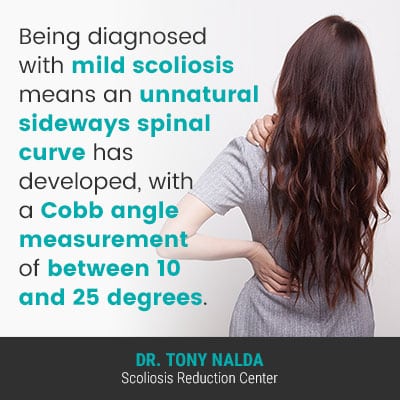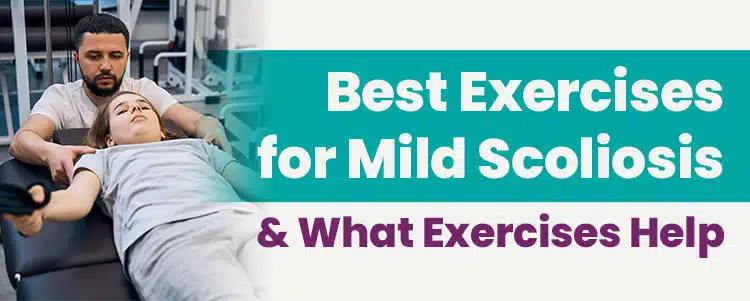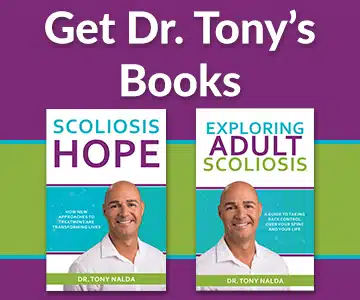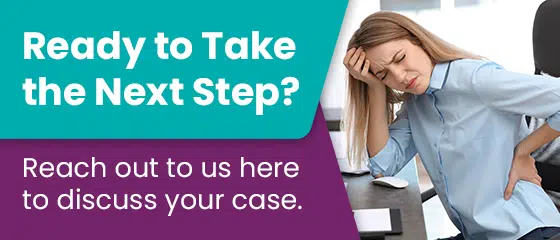There was once a time when the place of exercise in scoliosis treatment was questioned, but that was before we understood the difference between general exercise, and scoliosis-specific exercise. When it comes to mild scoliosis, corrective exercises, when integrated into a proactive treatment plan, can augment corrective results.
When it comes to the best exercises for mild scoliosis, we’re talking about exercises that can help keep the spine and its surrounding muscles as strong and loose as possible. When combined with other forms of proactive treatment, scoliosis-specific exercises can help achieve corrective treatment results.
Before getting to the specifics of the best exercises for mild scoliosis, let’s first talk about what a diagnosis of mild scoliosis means.
Being Diagnosed With Mild Scoliosis
Scoliosis is a complex structural spinal condition, and there are certain parameters that have to be met to reach a diagnosis of mild scoliosis.
Being diagnosed with scoliosis means an unnatural sideways spinal curve, with rotation, has developed; it’s the rotational component that makes scoliosis a 3-dimensional condition as the spine doesn’t just bend unnaturally but also twists from back to front, front to back.
In addition, a scoliotic curve has to be of a minimum size to be considered true scoliosis: a minimum Cobb angle measurement of 10 degrees.
A patient’s Cobb angle is determined during X-ray by drawing lines from the tops and bottoms of the curve’s most-tilted vertebrae, and the resulting angle is expressed in degrees.
A patient’s Cobb angle tells me how far out of alignment a scoliotic spine is and further classifies conditions based on severity:
- Mild scoliosis: Cobb angle measurement of between 10 and 25 degrees
- Moderate scoliosis: Cobb angle measurement of between 25 and 40 degrees
- Severe scoliosis: Cobb angle measurement of 40+ degrees
- Very-severe scoliosis: Cobb angle measurement of 80+ degrees
Generally speaking, the higher the Cobb angle, the more severe the condition, and the more likely its symptoms are to be noticeable.
In addition to scoliosis ranging widely in severity, there are also multiple condition types a person can develop.
The most common type of scoliosis is adolescent idiopathic scoliosis (AIS), diagnosed between the ages of 10 and 18, and the idiopathic designation means we don’t clearly understand what causes the condition to develop initially; what we do understand is what triggers it to progress.
Growth and development are the condition’s main progressive trigger, and scoliosis being a progressive condition, means it has it in its very nature to worsen over time, particularly if left untreated or not treated proactively.
Approximately 80 percent of known diagnosed scoliosis cases are classified as idiopathic, with the remaining 20 percent associated with known causes: neuromuscular, congenital, degenerative, and traumatic.

Being diagnosed with mild scoliosis means an unnatural sideways spinal curve has developed, with a Cobb angle measurement of between 10 and 25 degrees.
For individuals with mild scoliosis, typically measured at around 15 degrees, the best exercises are those tailored to strengthen and support the spine while promoting good posture and alignment.
Now that we know what being diagnosed with scoliosis means and the parameters that have to be met to reach a diagnosis of mild scoliosis, let’s talk about mild scoliosis symptoms.
Mild Scoliosis Symptoms
A diagnosis of mild scoliosis means the condition was detected and diagnosed early in its progressive line, and while someone recently diagnosed with scoliosis is not likely to be feeling fortunate, receiving a diagnosis while the condition is still mild means early detection was accomplished: not always easy to do.
Particularly in adolescent idiopathic scoliosis, early detection can be a challenge, and when it comes to mild conditions, this is especially true as mild forms don’t commonly cause functional deficits, and for adolescents, the condition isn’t generally painful.
While no one wants to experience pain, it does serve a vital function: it tells us something is wrong inside the body, so why isn’t mild scoliosis overly painful?
Scoliosis isn’t commonly described as painful for children and adolescents, and this is due to compression; scoliosis doesn’t become a compressive condition until adulthood when skeletal maturity is reached.
While spines are growing, they are experiencing a constant lengthening motion that counteracts the compressive force of the unnatural spinal curve, and it’s compression of the spine and its surrounding muscles and nerves that cause the majority of condition-related pain.
Engaging in a scoliosis workout that includes targeted exercises for dextroscoliosis can be beneficial for individuals with mild scoliosis, as these exercises are designed to help improve posture and spinal alignment, contributing to better overall spinal health. However, it’s important to consult with a healthcare professional for guidance on how to fix scoliosis effectively through appropriate exercises and treatments, avoiding those exercises that might make the condition worse.
So if mild scoliosis doesn’t generally cause any noticeable functional deficits and it’s not always painful, what are the early signs and symptoms of mild scoliosis to watch out for?
Clothing Fitting Unevenly
While adolescents outgrowing clothes quickly is not uncommon, for parents or caregivers noticing their adolescent’s clothing appears to be ill-fitting, this can indicate a disruption to the body’s overall symmetry.
Is clothing hanging unevenly? Do shirt sleeves and cuffs appear uneven? Do shirt arms and pant legs seem to hang at different lengths? Do the necklines of shirts always seem to be pulled more to one side than the other?
While ill-fitting clothing doesn’t guarantee the presence of scoliosis, it can indicate the need for further testing.
Changes to Balance and Coordination
While teenagers aren’t exactly known for standing up straight and practicing ideal posture, if there are noticeable changes to an adolescent’s balance and coordination, mild scoliosis can be the cause.
Issues with proprioception can also emerge, and this affects a person’s sense of body orientation in its particular environment.
Changes in Gait
When I’m examining a young patient and looking for indicators of scoliosis, observing their posture and how they walk can tell me a lot about their physical condition.
It’s not uncommon for mild scoliosis to reveal itself in the way an adolescent walks: arms can swing less, asymmetrical motion is noticeable, and there can be a reduction in the average amount of counter-rotating motion the body makes in the hips and shoulder.
Postural Deviation
Often, the earliest telltale signs of mild adolescent idiopathic scoliosis are uneven shoulders and hips, and this is due to the uneven forces the condition introduces to the body.
In addition to one shoulder sitting higher than the other, one shoulder blade protruding more on one side than the other, and one hip sitting higher than the other, the following are some additional mild scoliosis symptoms to watch out for:
- The head not being evenly centered over the body
- Arms appearing to hang at different lengths
- Ribs protruding more on one side than the other
- The body has a noticeable lean to one side when standing
- Legs appear to be different lengths
- An asymmetrical waist, with one side appearing flatter and the opposite appearing more curved
- Space between the arms and torso can appear asymmetrical
In general, any indication that the body’s overall symmetry has been disrupted can indicate the need for further testing to confirm the presence of mild scoliosis.
Pain
While each case is unique, generally, adolescents don’t experience scoliosis pain in the same way that adults do, and this is due to compression.
Scoliosis doesn’t become a compressive condition until adulthood, when skeletal maturity has been reached.
Growing spines are experiencing a constant lengthening motion that counteracts the compressive force of the unnatural spinal curve and its compression of the spine and its surrounding muscles and nerves that cause the majority of condition-related pain.
However, adolescents can still experience condition-related pain such as headaches, neck pain, back pain, hip pain, and/or shoulder pain, and it can be an indicator of mild scoliosis.
Compression-related pain can be severe and start once skeletal maturity has been reached in adulthood, and this is one of the reasons early detection can be so beneficial in terms of prevention, but the benefits of early detection are only available to those whose diagnosis is met with proactive treatment.
So what are the mild scoliosis treatment options?
Mild Scoliosis Treatment Options
Understanding the signs of mild scoliosis can lead to early detection and the benefits it can bring in terms of treatment efficacy.
Engaging in scoliosis correction exercises is essential for individuals with mild scoliosis as they help improve spinal alignment and posture, making them some of the best exercises to address this condition effectively.
While there are never treatment guarantees, early detection, when responded to with proactive treatment, means there are fewer limits to what we can achieve.
Scoliosis is simplest to treat while mild, and this is because as scoliosis progresses, the unnatural spinal curve increases in size, and the spine becomes increasingly rigid, making it less responsive to treatment, and the body is getting more used to the scoliotic curve’s presence.
There are two main scoliosis treatment approaches to choose between, and each offers patients a different potential outcome, which is why I want patients to be aware of all treatment options available to them.
For beginners with mild scoliosis seeking effective exercises, incorporating beginner correction scoliosis exercises into their routine can significantly aid in improving posture and reducing spinal curvature.
Scoliosis patients often find relief and improved spinal alignment through scoliosis physical therapy exercises tailored to their condition.
Running can be a beneficial exercise for individuals with mild scoliosis, as it helps promote overall fitness and can complement a well-rounded exercise routine aimed at managing scoliotic curvature effectively. Engaging in exercises for mild scoliosis, including proper techniques for activities like squatting with scoliosis, can help improve posture and strengthen the muscles supporting the spine. These exercises are essential for individuals with sclerosis of the spine as well.
The best exercises to correct scoliosis, including gentle stretches and strengthening routines, can significantly benefit individuals of all ages, with tailored scoliosis exercises for seniors focusing on improving flexibility, balance, and overall spinal health.
When managing mild scoliosis, it’s important to incorporate specific exercises with caution; while YouTube, for example, can offer helpful scoliosis exercises, it’s crucial to only follow those recommended by a professional to ensure they are safe and effective for your condition.
Scoliosis exercises for the elderly, such as gentle stretching and core-strengthening routines, can significantly help in managing mild scoliosis by improving flexibility and reducing discomfort.
The two main scoliosis treatment options patients have to choose between are traditional and conservative, and as the traditional approach was the dominant choice for many years, let’s start there.
Traditional Mild Scoliosis Treatment
When it comes to traditional mild scoliosis treatment, the term is somewhat of a misnomer, and you’ll understand why shortly.
When talking about traditional scoliosis treatment, we’re talking about an approach that’s more reactive than proactive and values observation over applying proactive treatment as close to the time of diagnosis as possible.
A traditional scoliosis treatment provider would recommend that an adolescent with mild scoliosis return for periodic assessments to monitor for signs of further progression, but being a progressive condition, we know that scoliosis is going to progress at some point.
Periodic assessments can be done every 3, 6, or even 12 months, depending on the recommendation of the traditional treatment provider, but as mentioned earlier, growth and development is the condition’s main trigger.
As we’re talking about adolescent idiopathic scoliosis, these are adolescents who are in, or are entering into, the stage of puberty characterized by rapid and unpredictable growth spurts, so what happens if, in between assessments, an adolescent has an extreme growth spurt?
What can happen is significant progression, and now, the condition is going to be harder to treat.
Traditional treatment doesn’t address mild scoliosis proactively, quite simply, because it doesn’t have a strategy for treating scoliosis while mild and is shaped around a surgical response for severe cases.
Once a condition progresses past the surgical-level threshold at 40+ degrees and shows signs of continued progression, patients are commonly funneled toward spinal fusion surgery.
While there is a place for spinal fusion surgery in the treatment of severe and very-severe scoliosis, spinal fusion is an invasive, lengthy, and costly procedure that comes with some serious potential risks, side effects, and complications.
The main issue I have with traditional scoliosis treatment is that had proactive treatment been applied while the condition was still mild, progression could have been prevented, and patients can be spared the hardships associated with increasing condition severity, escalating symptoms, and the need for invasive surgical treatment in the future.
The reality is that most cases of scoliosis can be treated non-surgically, which is where conservative non-surgical scoliosis treatment comes in.
Conservative Mild Scoliosis Treatment
Here at the Scoliosis Reduction Center®, I believe in the merits of proactive treatment starting as close to the time of diagnosis as possible because my treatment goals are centered around prevention.
Patients of the Center benefit from a modern conservative chiropractic-centered treatment approach that integrates multiple forms of condition-specific treatment, so the condition is impacted on every level.
As a structural condition, mild scoliosis has to, first and foremost, be impacted on a structural level, and this is worked towards through curvature reduction and chiropractic care.
But it’s not just the spine that’s in charge of maintaining its natural curves and alignment; it’s the spine’s surrounding muscles that provide it with support, and this is where the best exercises for mild scoliosis can help.
Being certified in SEAS, the scientific exercise approach to scoliosis, and familiar with the therapeutic benefit of Schroth exercises, I can use a variety of scoliosis exercises, physical therapy and stretches to prevent mild scoliosis from becoming moderate, severe, or very-severe scoliosis.
Mild Scoliosis Exercises
As mentioned earlier, there is an important distinction to be made between general exercises for scoliosis and scoliosis-specific exercises (SSEs); the former can be helpful with maintaining general health and wellness, but to augment corrective results, scoliosis exercises have to be condition-specific and combined with other forms of proactive treatment with corrective potential.
You’ll hear me saying corrective results often, and in the context of scoliosis, this means achieving a curvature reduction on a structural level and core-strengthening exercises for optimal spinal support and stabilization.
The best exercises for mild scoliosis include physiotherapeutic scoliosis-specific exercises, and incorporating dextroscoliosis exercises with picture guides can greatly enhance the effectiveness of the treatment.
Discovering the best exercises for mild scoliosis, including specific routines for levoscoliosis, can significantly aid in managing the condition and promoting spinal health.
It should also be stated clearly that no form of scoliosis exercises to straighten spine should be attempted or integrated into a scoliosis treatment plan without first being cleared by the scoliosis treatment provider.
So what exercises help mild scoliosis treatment?
Seated Butterfly Stretch
The seated butterfly stretch is a type of hip-flexion exercise. The hip is an essential structure when it comes to maintaining balance and posture as the hip flexors use many muscles that impact movement in the lower back, the thighs, hips, psoas, and sartorius muscles.
Explore the best exercises for mild scoliosis, accompanied by helpful pictures, to enhance your understanding and effectively incorporate targeted workouts into your routine.
Tight hip flexors can cause lower back pain and injury; stretching and strengthening tight hip flexors can help improve flexibility, and as uneven hips are one of the early signs of mild scoliosis, this means that one hip is taking on more weight than the other, so any exercise that facilitates flexibility and improves balance can help with mild scoliosis.
The seated butterfly stretch is an effective way to keep the hip flexors functioning optimally and can be performed easily at home without the use of equipment:
To perform the seated butterfly stretch, follow these steps:
- Sit in a seated position
- Fold both legs in front of the body; the soles of the feet should be touching.
- While sitting up straight, engage the core muscles
- Gently exhale while bending forward at the hips
- Rest the elbows gently on the thighs
- While keeping the back straight, hold the position for 15 to 30 seconds

Strengthening and loosening the hips can help with balancing the body and counteracting the asymmetrical effects of scoliosis.
Flexion and Extension Exercises for Mild Scoliosis
Flexor muscles help with bending motions, while extensor muscles help with straightening or extending.
Maintaining the balance between the spine’s flexor and extensor muscles means the spine’s supportive muscles are strong, loose, balanced, and facilitate the smooth motion of the joints during movement.
Cervical Flexion Exercise for Mild Scoliosis
This cervical flexion exercise helps strengthen the flexor muscles in the front or the neck, so a good balance between the strength of the neck’s front muscles (cervical flexors) and the neck’s back muscles (cervical extensors) is maintained; this helps prevent a loss of the neck’s healthy inward curve (lordosis) and the development of forward head posture.
The neck has to support its own weight and the weight of the head, so it’s important to keep the flexors and extensors strong, loose, and balanced.
To perform the cervical flexion exercise, follow these steps:
- Lie down on the back with a foam roll under the neck (a rolled-up towel will also suffice)
- With the fingertips on the forehead, resist lightly against the fingertips while tucking the chin
- Perform this without allowing the head to move
This is an example of an isometric exercise (one that’s performed without motion and against resistance), and this is the most effective type of exercise for strengthening the abdominal muscles that affect posture.
Lumbar Extension Exercise for Mild Scoliosis
The lumbar extension exercise targets the extensor muscles of the lower back. It’s said that everyone will experience lower back pain at some point in their lives, and this is because the vertebrae of the lumbar spine have to support the weight of the entire spine and the trunk.
The lumbar spine also feels the effects of bending, twisting, and lifting motions.
To perform the lumbar extension exercise, follow these steps:
- Sit on a stool
- Place the hands on the knees
- Look upwards while arching the lower back
- Pull the knees with the fingers, or push with the palms, to exaggerate the lower back’s curve, while keeping the shoulders back and the chin up
- Hold the position for five seconds
Keeping the lumbar spine’s extensor muscles strong and loose helps support the lower back and keep them balanced, helping the spine to maintain its natural and healthy curves, and this also affects the pelvis and hips and enables smooth motion.
Chest Expander Exercise for Mild Scoliosis
The chest expander exercise helps maintain the thoracic spine’s healthy curve, stretches the rhomboid muscles, and can improve lung capacity by creating space for the lungs to function optimally.
While scoliosis can develop in any of the spine’s sections, it’s most commonly found in the thoracic spine, which makes sense as this is the largest spinal section, containing the most vertebrae.
While lung impairment isn’t associated with mild scoliosis, it is associated with more severe forms and can become an issue if mild scoliosis is left untreated.
To perform the chest expander exercise, follow these steps:
- While standing upright, bring the hands above the head while inhaling deeply
- Push the hands together as they are brought down and exhale at the same time
- Press the hands into the diaphragm, below the ribs, to expel the remaining air
- Take a deep breath while continuing to press against the diaphragm
- When the lungs are full, pull the hands away so the rib cage expands as air fills the lungs
- The chin should be kept up throughout the exercise
- Repeat 10 times, twice a day
This exercise should be performed by leaning into the primary curve; for example, if the largest curve bends to the right, lean to the right. This helps engage the respiratory muscles and lungs more on one side than the other.
If the primary curve is in the upper thoracic spine, perform the exercise while standing; if it’s in the lumbar spine, perform it while seated.
Conclusion
When it comes to managing mild scoliosis, incorporating the best exercises can be a significant component of a holistic approach. While there are different scoliosis treatments available, physiotherapy for scoliosis, also known as physical therapy, can offer valuable guidance.
Engaging in specific exercises tailored to your condition can help improve posture, strengthen the core, and enhance overall spinal health. While it’s essential to consult with a healthcare professional to determine the best treatment for scoliosis in your particular case, incorporating these exercises into your routine can be a natural way to support your spine’s well-being and potentially reduce the impact of scoliosis.
Hypolordosis is also a condition often associated with mild scoliosis, and knowing the best exercises that help improve spinal alignment is crucial for those seeking relief.
When it comes to scoliosis exercises, no exercises for scoliosis can achieve corrective results on their own, but when integrated into a proactive treatment plan that combines multiple treatment disciplines, a corrective exercise specialist and/or physical therapist can help augment corrective results.
Here at the Scoliosis Reduction Center®, patients benefit from conservative chiropractic treatment that involves the combination of different treatment modalities so conditions can be impacted on every level.
By receiving multiple certifications and training in a variety of condition-specific therapies, including the Schroth method and physiotherapy scoliosis-specific exercises, I can use chiropractic treatment to impact the condition on a structural level, corrective bracing to push the spine into a corrective position, and core-strengthening exercises, so the spine is optimally supported by its surrounding muscles.
In addition, the prescription of corrective exercises can help establish a home exercise program for further rehabilitation and stabilization of the spine.
The important thing to understand about a mild scoliosis diagnosis is that it’s not a static condition, and unless proactive treatment is applied, it’s virtually guaranteed to progress.
Here at the Center, I apply proactive treatment as close to the time of diagnosis as possible in order to address the scoliotic curve when it’s going to be most responsive to treatment.
If too much spinal rigidity has set in, which increases alongside progression, the ability to perform corrective exercises is impaired; when this happens, work has to be done before starting the regular course of treatment to establish a baseline level of spinal flexibility.
So if you, or someone you love, has noticed the early signs of mild scoliosis, the best time to seek support, guidance, and treatment is always now; that way, patients can be spared the hardships associated with increasing condition severity, escalating symptoms, and the need for invasive treatment in the future.
Reaching out to us here can set you on the path of proactive non-surgical scoliosis treatment that strives to preserve as much natural spinal function as possible throughout treatment and beyond.




